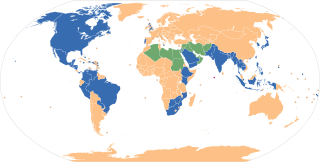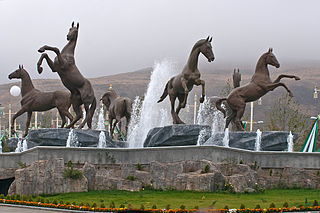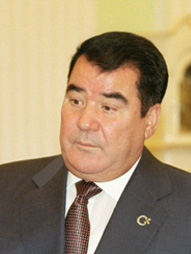Related Research Articles
The Julian calendar is a solar calendar of 365 days in every year with an additional leap day every fourth year. The Julian calendar is still used as a religious calendar in parts of the Eastern Orthodox Church and in parts of Oriental Orthodoxy as well as by the Amazigh people.

The history of Turkmenistan traditionally began with the arrival of Indo-European Iranian tribes around 2000 BC. Early tribes were nomadic or semi-nomadic due to the arid conditions of the region, preventing widespread adoption of agriculture. The steppe culture in Central Asia was an extension of a larger Eurasian series of horse cultures which spanned the entire spectrum of language families, including the Indo-Europeans and Turko-Mongol groups. Some of the known early Iranian tribes included the Massagatae, the Scythians/Sakas, and early Soghdians, who were most likely precursors of the Khwarezmians. Turkmenistan was a passing point for numerous migrations and invasions by tribes, which gravitated towards the settled regions of the south, including ancient Mesopotamia, Elam, and the Indus Valley civilization.

The politics of Turkmenistan nominally takes place in the framework of a presidential republic, whereby the President of Turkmenistan is nominally both head of state and head of government. However, as of 21 January 2023 a "national leader" was appointed who chairs an independent People's Council (viz.) with authority to amend the constitution, and who exercises supreme political authority. No true opposition parties are allowed; every registered political party supports the third and current President Serdar Berdimuhamedow. The country is frequently described as a totalitarian state.

A week is a unit of time equal to seven days. It is the standard time period used for short cycles of days in most parts of the world. The days are often used to indicate common work days and rest days, as well as days of worship. Weeks are often mapped against yearly calendars, but are typically not the basis for them, as weeks are not based on astronomy.

Turkmenistan is a country in Central Asia bordered by Kazakhstan to the northwest, Uzbekistan to the north, east and northeast, Afghanistan to the southeast, Iran to the south and southwest and the Caspian Sea to the west. Ashgabat is the capital and largest city. It is one of the six independent Turkic states. With a population of 6.5 million, Turkmenistan is the 35th most-populous country in Asia and has the lowest population of the Central Asian republics while being one of the most sparsely populated nations on the Asian continent.

The Turkmen Soviet Socialist Republic, also known as Soviet Turkmenistan, the Turkmen SSR, Turkmenistan, or Turkmenia, was one of the constituent republics of the Soviet Union located in Central Asia existed as a republic from 1925 to 1991. Initially, on 7 August 1921, it was established as the Turkmen Oblast of the Turkestan ASSR before being made, on 13 May 1925, a separate republic of the USSR as the Turkmen SSR.
Saparmyrat Nyýazow (1940–2006), known as Türkmenbaşy, lit. 'head of the Turkmen', was the dictator of Turkmenistan from 1985 to 2006. He coined the title for himself, and subsequently either named or renamed various places to it.

The Ruhnama, or Rukhnama, translated into English as Book of the Soul, is a two volume work written by Saparmurat Niyazov, the president of Turkmenistan from 1990 to 2006. It was intended to serve as a tool of state propaganda, emphasising the basis of the Turkmen nation.

Turkmenistan's human rights record has been heavily criticized by various countries and scholars worldwide. Standards in education and health declined markedly during the rule of President Saparmurat Niyazov.

Magtymguly Pyragy, born Magtymguly, was a Turkmen spiritual leader, philosophical poet, Sufi and traveller who is considered to be the most famous figure in Turkmen literary history.

Old Style (O.S.) and New Style (N.S.) indicate dating systems before and after a calendar change, respectively. Usually, this is the change from the Julian calendar to the Gregorian calendar as enacted in various European countries between 1582 and 1923.

The manat is the currency of Turkmenistan. The original manat was introduced on 1 November 1993, replacing the rouble at a rate of 1 manat = Rbls 500. The manat is subdivided into 100 tenge.

Gyzylarbat is a city subordinate to a district in Turkmenistan, located north-west of the capital, Ashgabat on the M37 highway to the Caspian Sea. The population of Gyzylarbat is 50,000 people, mainly Turkmen. The main language spoken in the region is Turkmen. It is near the northwest end of the line of oases on the north slope of the Kopet Dag that extends southeast to Ashgabat.
Turkmenization is the set of domestic policies the Niyazov administration used in Turkmenistan from 1991 to December 2006 to force ethnic minorities to adopt Turkmen culture. Those who resisted the state-sponsored cultural transformation were often deported.
The Turkmen of Turkmenistan, are predominantly Muslims. According the U.S. Department of State's International Religious Freedom Report for 2022,
According to U.S. government estimates, the country is 89 percent Muslim, 9 percent Eastern Orthodox, and 2 percent other. There are small communities of Jehovah's Witnesses, Shia Muslims, Baha’is, Roman Catholics, the International Society for Krishna Consciousness, and evangelical Christians, including Baptists and Pentecostals. Most ethnic Russians and Armenians identify as Orthodox Christian and generally are members of the Russian Orthodox Church or Armenian Apostolic Church. Some ethnic Russians and Armenians are also members of smaller Protestant groups. There are small pockets of Shia Muslims, consisting largely of ethnic Iranians, Azeris, and Kurds, some located in Ashgabat, with others along the border with Iran and in the western city of Turkmenbashy.

Saparmurat Atayevich Niyazov, also known as Türkmenbaşy, was a Turkmen politician who ruled Turkmenistan from 1985 until his death in 2006. He was first secretary of the Turkmen Communist Party from 1985 until 1991 and supported the 1991 Soviet coup attempt. He continued to rule Turkmenistan for 15 years after independence from the Soviet Union in 1991.
The Gregorian calendar is the calendar used in most parts of the world. It went into effect in October 1582 following the papal bull Inter gravissimas issued by Pope Gregory XIII, which introduced it as a modification of, and replacement for, the Julian calendar. The principal change was to space leap years differently so as to make the average calendar year 365.2425 days long, more closely approximating the 365.2422-day 'tropical' or 'solar' year that is determined by the Earth's revolution around the Sun.
The cinema of Turkmenistan dates back to the 1920s, when the country was within the Soviet Union. Since independence in 1991, Turkmenistan has had the most limited film production industry of any Central Asian state.
Gurbansoltan Niýazowa, known as Gurbansoltan Eje, neeAtamyradowa, was the mother of the first post-Soviet president of Turkmenistan, Saparmyrat Nyýazow ("Türkmenbaşy"). She was killed in the 1948 Ashgabat earthquake, leaving the eight year old Saparmyrat an orphan.

The adoption of the Gregorian Calendar was an event in the early modern history of most cultures and societies, marking a change from their traditional dating system to the modern dating system – the Gregorian calendar – that is widely used around the world today. Some states adopted the new calendar from 1582, some did not do so before the early twentieth century, and others did so at various dates between. A few still have not, but except for these, the Gregorian calendar is now the world's civil calendar universally, although in many places an old style calendar remains used in religious or traditional contexts. During – and for some time after – the change between systems, it has been common to use the terms "Old Style" and "New Style" when giving dates, to indicate which calendar was used to reckon them.
References
- 1 2 Туркменам вернули прежний календарь, Lenta.ru, July 1, 2008 (in Russian)
- ↑ "Turkmen Go Back to Old Calendar". BBC News . 24 April 2008. Retrieved 30 December 2016.